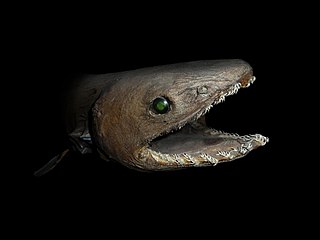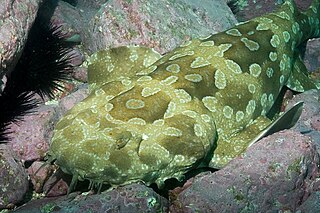
The frilled shark and the southern African frilled shark are the two extant species of shark in the family Chlamydoselachidae. The frilled shark is considered a living fossil, because of its primitive, anguilliform (eel-like) physical traits, such as a dark-brown color, amphistyly, and a 2.0 m (6.6 ft)–long body, which has dorsal, pelvic, and anal fins located towards the tail. The common name, frilled shark, derives from the fringed appearance of the six pairs of gill slits at the shark's throat.

Rajiformes is one of the four orders in the superorder Batoidea, flattened cartilaginous fishes related to sharks. Rajiforms are distinguished by the presence of greatly enlarged pectoral fins, which reach as far forward as the sides of the head, with a generally flattened body. The undulatory pectoral fin motion diagnostic to this taxon is known as rajiform locomotion. The eyes and spiracles are located on the upper surface of the head and the gill slits are on the underside of the body. Most species give birth to live young, although some lay eggs enclosed in a horny capsule.

The dumb gulper shark is a rare and endangered deepwater dogfish, known from only along the east coast of Australia and isolated spots north and west of New Zealand. It is also known as the dumb shark, Harrison's deep-sea dogfish, or Harrison's dogfish.

The spotted wobbegong is a carpet shark in the family Orectolobidae, endemic to Australia. It is a large, robust species, typically reaching 150–180 centimetres (59–71 in) in length. Coloured green, yellow, or brown, it has distinctive O-shaped spots throughout its body. It is nocturnal, resting at day and feeding on fish and invertebrates at night. An ovoviviparous species, the spotted wobbegong gives birth in the spring, during which time males can act aggressively towards other males and females. It has been known to bite humans, sometimes unprovoked, which can produce severe wounds. The species is fished for commercially in Australia, but it is not severely threatened. It is listed as a least-concern species on the IUCN Red List.

The Australian swellshark or draughtboard shark, is a species of catshark, and part of the family Scyliorhinidae, endemic to southern Australia. This bottom-dwelling species can be found on the continental shelf down to a depth of 220 m (720 ft). Usually measuring 1 m long, it is a stout-bodied, broad-headed shark with a short tail and a first dorsal fin much larger than the second. It can be identified by its variegated dorsal coloration of brown or grey patches and numerous spots.

The spotted houndshark, Triakis maculata, is a houndshark of the family Triakidae found in tropical waters in the eastern Pacific Ocean off the coast of South America. It usually grows to a length around 180 centimetres (71 in). The reproduction of this houndshark is ovoviviparous, with a litter of 14 pups being found in one female with a birth size of 30 to 40 centimetres. Their diet is believed to consist mainly of crustaceans.
The lizard catshark is a small shark species of the catshark family, Scyliorhinidae, found off the coast of southern Brazil on the upper continental shelf at depths of between 250 and 500 metres.

The quagga catshark is a species of catshark, belonging to the family Scyliorhinidae. A small, slim-bodied shark reaching 37 cm (15 in) in length, it has a distinctive color pattern of narrow, dark brown vertical bars, which resemble those of the quagga. Its head is short and flattened, with a pointed snout tip that is not upturned.

The African sawtail catshark is a species of catshark, part of the family Scyliorhinidae. Demersal in nature, it is found at depths of 160–720 m (520–2,360 ft) off the western African coast from Morocco to South Africa. This slender species has a rather long, pointed snout, a series of dark saddles along the back and tail, and a prominent crest of enlarged dermal denticles along the upper edge of the caudal fin. Its maximum known length is 46 cm (18 in).

The Australian angelshark is a species of angelshark, family Squatinidae, found in the subtropical waters of southern Australia from Western Australia to New South Wales between latitudes 18°S and 41°S, at depths down to 255 m (840 ft). Its length is up to 1.52 m (5 ft). Reproduction is ovoviviparous, with up to 20 pups in a litter.

The spotback skate is a species of fish in the family Arhynchobatidae. It is found off the Atlantic coasts of Argentina, Brazil, and Uruguay where its natural habitat is over the continental shelf in the open sea. It is a large fish, growing to over a metre in length. It feeds mainly on other fish according to availability, with shrimps, octopuses and other invertebrates also being eaten. Reproduction takes place throughout most of the year, with the eggs being laid in capsules that adhere to the seabed. The spotback skate is the subject of a fishery and is thought to be overfished, resulting in Greenpeace adding the fish to its red list of fish to be avoided, and the International Union for Conservation of Nature listing it as an "endangered species".

Callorhinchus, the plough-nosed chimaeras or elephantfish, are the only living genus in the family Callorhinchidae. A few extinct genera only known from fossil remains are recognized. Callorhinchus spp, are similar in form and habits to other chimaeras, but are distinguished by the presence of an elongated, flexible, fleshy snout, with a vague resemblance to a ploughshare. They are only found in the oceans of the Southern Hemisphere along the ocean bottom on muddy and sandy substrates. They filter feed, with small shellfish making up the bulk of their diet. The plough-nosed chimaera lays eggs on the ocean floor that hatch at around 8 months. They are currently not a target of conservation efforts; however, they may be susceptible to overfishing and trawling.

The argus skate is a species of fish in the family Rajidae. This small, up to 38 cm (1.25 ft) long, skate is endemic to depths of 135–320 m (443–1,050 ft) in the oceans off northeast Australia. It was formerly included in Dipturus or Raja.

The smalleyed ray or smalleyed skate is a species of ray in the family Rajidae, the typical rays and skates, from the eastern Atlantic Ocean where it is found in tidal, coastal waters with sandy substrates.

The sandyback stingaree or great stingaree is a little-known species of stingray in the family Urolophidae, endemic to southeastern Australia. It is generally found offshore around the edge of the continental shelf, at a depth of 65–265 m (213–869 ft). A relatively large species reaching 89 cm (35 in) long, the sandyback stingaree has a diamond-shaped pectoral fin disc wider than long, usually with a dorsal pattern of numerous fine lighter marks on a yellowish to brownish background. Its short tail terminates in a deep, leaf-shaped caudal fin, and bears a sizable dorsal fin just in front of the stinging spine.

Batoidea is a superorder of cartilaginous fishes, commonly known as rays. They and their close relatives, the sharks, comprise the subclass Elasmobranchii. Rays are the largest group of cartilaginous fishes, with well over 600 species in 26 families. Rays are distinguished by their flattened bodies, enlarged pectoral fins that are fused to the head, and gill slits that are placed on their ventral surfaces.

The graytail skate, or gray tail skate, is a large species of skate in the family Arhynchobatidae, native to the south-western Atlantic Ocean and south-eastern Pacific Ocean. It is listed as endangered by the IUCN. It was caught as part of a commercial fishery around the Falkland Islands and is a bycatch in several other fisheries.
The Philippine spurdog or Indonesian greeneye spurdog, is a relatively large species of dogfish shark native to waters off the coast of Australia, the Philippines, and Indonesia. The species was identified in 1912 from a specimen caught off the coast of Luzon Island, and has been both bycatch and a targeted species in fisheries since. Its taxonomy is complex, having been renamed in 1931, being misidentified as a type of shortspine spurdog, then being revived as a species in 2007.
The greeneye spurdog is a species of dogfish described in 2007. It is a member of the family Squalidae, found off the coast of southeastern Australia. The length of the longest specimen measured is 85.6 cm (33.7 in). It was considered conspecific with the shortspine spurdog.

The grey skate is a species of fish in the family Rajidae. It was described in 2008 by Australian ichthyologist Peter R. Last.


















